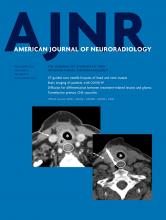Index by author
Takahashi, Y.
- Adult BrainYou have accessDetailed Arterial Anatomy and Its Anastomoses of the Sphenoid Ridge and Olfactory Groove Meningiomas with Special Reference to the Recurrent Branches from the Ophthalmic ArteryM. Hiramatsu, K. Sugiu, T. Hishikawa, J. Haruma, Y. Takahashi, S. Murai, K. Nishi, Y. Yamaoka, Y. Shimazu, K. Fujii, M. Kameda, K. Kurozumi and I. DateAmerican Journal of Neuroradiology November 2020, 41 (11) 2082-2087; DOI: https://doi.org/10.3174/ajnr.A6790
Tames, H.L.V.C.
- Head and Neck ImagingOpen AccessCross-Sectional Imaging of Third Molar–Related AbnormalitiesR.M. Loureiro, D.V. Sumi, H.L.V.C. Tames, S.P.P. Ribeiro, C.R. Soares, R.L.E. Gomes and M.M. DanielAmerican Journal of Neuroradiology November 2020, 41 (11) 1966-1974; DOI: https://doi.org/10.3174/ajnr.A6747
Tang, S.Y.
- FELLOWS' JOURNAL CLUBSpine Imaging and Spine Image-Guided InterventionsYou have accessVariability of T2-Relaxation Times of Healthy Lumbar Intervertebral Discs is More Homogeneous within an Individual Than across Healthy IndividualsA. Sharma, R.E. Walk, S.Y. Tang, R. Eldaya, P.J. Owen and D.L. BelavyAmerican Journal of Neuroradiology November 2020, 41 (11) 2160-2165; DOI: https://doi.org/10.3174/ajnr.A6791
Using prospectively acquired T2-relaxometry data from 606 intervertebral discs in 101 volunteers without back pain in a narrow age range (25–35 years), the authors calculated intra- and intersubject variation in T2 times of IVDs graded by 2 neuroradiologists on the Pfirrmann scale. Intrasubject variation of IVDs was assessed relative to other healthy IVDs (Pfirrmann grade, #2) in the same individual. Multiple intersubject variability measures were calculated using healthy extraneous references ranging from a single randomly selected IVD to all healthy extraneous IVDs, without and with segmental stratification. They conclude that the study demonstrates a significantly higher variation in the T2 times of IVDs across subjects, and suggests that normative measures based on the T2 times of healthy lumbar IVDs from the same individual are likely to provide the most discriminating means of identifying degenerated IVDs on the basis of T2 relaxometry.
Thomas, Bejoy
- You have accessPerspectivesBejoy ThomasAmerican Journal of Neuroradiology November 2020, 41 (11) 1963; DOI: https://doi.org/10.3174/ajnr.P0076
Tihan, T.
- EDITOR'S CHOICEAdult BrainOpen AccessCentrally Reduced Diffusion Sign for Differentiation between Treatment-Related Lesions and Glioma Progression: A Validation StudyP. Alcaide-Leon, J. Cluceru, J.M. Lupo, T.J. Yu, T.L. Luks, T. Tihan, N.A. Bush and J.E. Villanueva-MeyerAmerican Journal of Neuroradiology November 2020, 41 (11) 2049-2054; DOI: https://doi.org/10.3174/ajnr.A6843
Images of 231 patients who underwent an operation for suspected glioma recurrence were reviewed. Patients with susceptibility artifacts or without central necrosis were excluded. The final diagnosis was established according to histopathology reports. Two neuroradiologists classified the diffusion patterns on preoperative MR imaging as the following: 1) reduced diffusion in the solid component only, 2) reduced diffusion mainly in the solid component, 3) no reduced diffusion, 4) reduced diffusion mainly in the central necrosis, and 5) reduced diffusion in the central necrosis only. A total of 103 patients were included (22 with treatment-related lesions and 81 with tumor progression). The diagnostic accuracy results for the centrally reduced diffusion pattern as a predictor of treatment-related lesions (“mainly central” and “exclusively central” patterns versus all other patterns) were: 64% sensitivity, 84% specificity, 52% positive predictive value, and 89% negative predictive value.
Toma, N.
- FELLOWS' JOURNAL CLUBSpine Imaging and Spine Image-Guided InterventionsYou have accessCauda Equina and Filum Terminale Arteriovenous Fistulas: Anatomic and Radiographic FeaturesK. Namba, Y. Niimi, T. Ishiguro, A. Higaki, N. Toma and M. KomiyamaAmerican Journal of Neuroradiology November 2020, 41 (11) 2166-2170; DOI: https://doi.org/10.3174/ajnr.A6813
Intradural AVF below the conus medullaris may develop either on the filum terminale or the cauda equina (lumbosacral and coccygeal radicular nerves). Only 3 detailed cauda equina AVFs have been reported in the literature. The authors present the angiographic and MR imaging findings of cauda equina and filum terminale AVF cases, supplemented with literature research to characterize the radiologic features of the 2 entities. On angiography, filum terminale AVFs were invariably supplied by the extension of the anterior spinal artery accompanied by a closely paralleling filum terminale vein. Cauda equina AVFs were fed by either a radicular or a spinal artery or both arteries, often with a characteristic wavy radicular-perimedullary draining vein.
Torres, C.
- Adult BrainOpen AccessThe Perplexity Surrounding Chiari Malformations – Are We Any Wiser Now?S.B. Hiremath, A. Fitsiori, J. Boto, C. Torres, N. Zakhari, J.-L. Dietemann, T.R. Meling and M.I. VargasAmerican Journal of Neuroradiology November 2020, 41 (11) 1975-1981; DOI: https://doi.org/10.3174/ajnr.A6743
Trivelato, F.P.
- NeurointerventionYou have accessTransarterial Treatment of Cranial Dural Arteriovenous Fistulas: The Role of Transarterial and Transvenous Balloon-Assisted EmbolizationJ.O. Zamponi, F.P. Trivelato, M.T.S. Rezende, R.K. Freitas, L.H. de Castro-Afonso, G.S. Nakiri, T.G. Abud, A.C. Ulhôa and D.G. AbudAmerican Journal of Neuroradiology November 2020, 41 (11) 2100-2106; DOI: https://doi.org/10.3174/ajnr.A6777
Tsuji, M.
- NeurointerventionOpen AccessComputational Fluid Dynamics Using a Porous Media Setting Predicts Outcome after Flow-Diverter TreatmentM. Beppu, M. Tsuji, F. Ishida, M. Shirakawa, H. Suzuki and S. YoshimuraAmerican Journal of Neuroradiology November 2020, 41 (11) 2107-2113; DOI: https://doi.org/10.3174/ajnr.A6766








